Ahsan A. Two Phase Flow, Phase Change and Numerical Modeling
Подождите немного. Документ загружается.


Thermal Energy Storage Tanks Using Phase Change Material (PCM) in HVAC Systems
549
Exp. no
Input temp.
[°C]
Flow rate
[L/min]
Ar
in
[-]
Inlet heat
[kW]
SA01-11-2 10.8 6.0 2.76E-02 4.5
SA01-21-2 13.0 5.0 7.83E-02 4.5
SA01-31-2 15.4 4.0 2.03E-01 4.3
SA01-12-2 14.5 11.3 2.16E-01 11.4
SA01-22-2 18.3 8.9 6.78E-02 11.4
SA01-32-2 25.2 7.9 1.85E-01 13.9
SA01-42-2 10.5 15.5 3.61E-03 11.4
SA01-13-2 14.7 35.8 2.08E-02 36.7
SA01-23-2 18.3 27.7 6.30E-02 35.2
SA01-33-2 24.5 20.8 2.27E-01 35.6
SA01-43-2 15.3 33.8 2.87E-03 36.0
Table 4. Experimental conditions of the melting process for the ice-on-coil ice storage tank
with IPF 10%
Fig. 7. Freezing process in the experiment using the ice-on-coil ice storage tank
Fig. 8. Melting process for large Archimedes number and inlet enthalpy flow rate
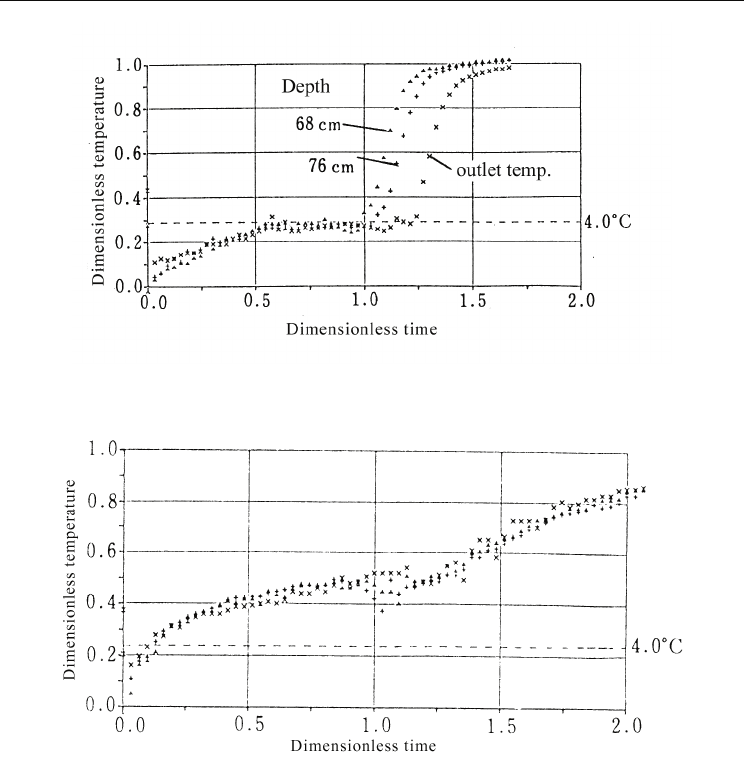
Two Phase Flow, Phase Change and Numerical Modeling
550
Fig. 9. Melting process for large Archimedes number and moderate inlet enthalpy flow rate
Fig. 10. Melting process for small Archimedes number
2.5 Effect of main parameters on efficiencies
The relationship among efficiency, Archimedes number, and inlet enthalpy flow rate is
analyzed in this section. The efficiency depends on the limit temperature to the coils of the
air handling units. Even though the value of the limit temperature depends on the design
conditions of the air handling units, in the present study, the limit temperature was set to
4°C based on the above results. Figure 11 shows the relationship among η, Archimedes
number, and inlet enthalpy flow rate. The effect on outlet response is more pronounced for
the Archimedes number than for the enthalpy flow rate. This means that larger Archimedes
numbers produce lower outlet temperatures. Figure 12 shows the relationship among η
0
,
Archimedes number, and inlet enthalpy flow rate. In this case, the enthalpy flow rate has
more influence on the response than in the case of η.
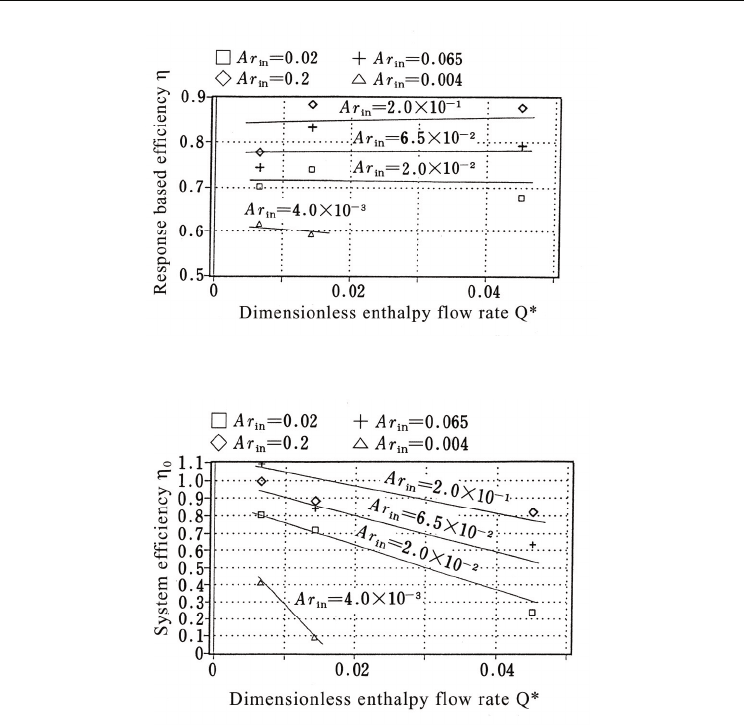
Thermal Energy Storage Tanks Using Phase Change Material (PCM) in HVAC Systems
551
Fig. 11. Relationship between response-based efficiency η
and inlet conditions
Fig. 12. Relationship between system efficiency η
0
and inlet conditions
2.6 Thermal response of the slurry ice storage tank
The dynamic ice making method, which makes ice using an additional device, is an
alternative to the ice-on-coil ice storage tank. Since ice is intermittently or continuously
removed from the surface of an ice making heat exchanger, no thermal resistance occurs, as
in the case of the ice-on-coil ice storage tank. There are several types of dynamic ice making
processes, which use a diluted glycol solution or the sub-cooling phenomenon of water. In
the present paper, experiments were conducted on a dynamic ice storage tank using sub-
cooled water.
2.6.1 Experimental setup and conditions
The experimental setup is shown in Figure 13 and includes a sub-cooling heat exchanger,
which cools water to 2ºC below the freezing point. The sub-cooled water was injected into
the tank and collided with a plate at which the sub-cooled state was released.
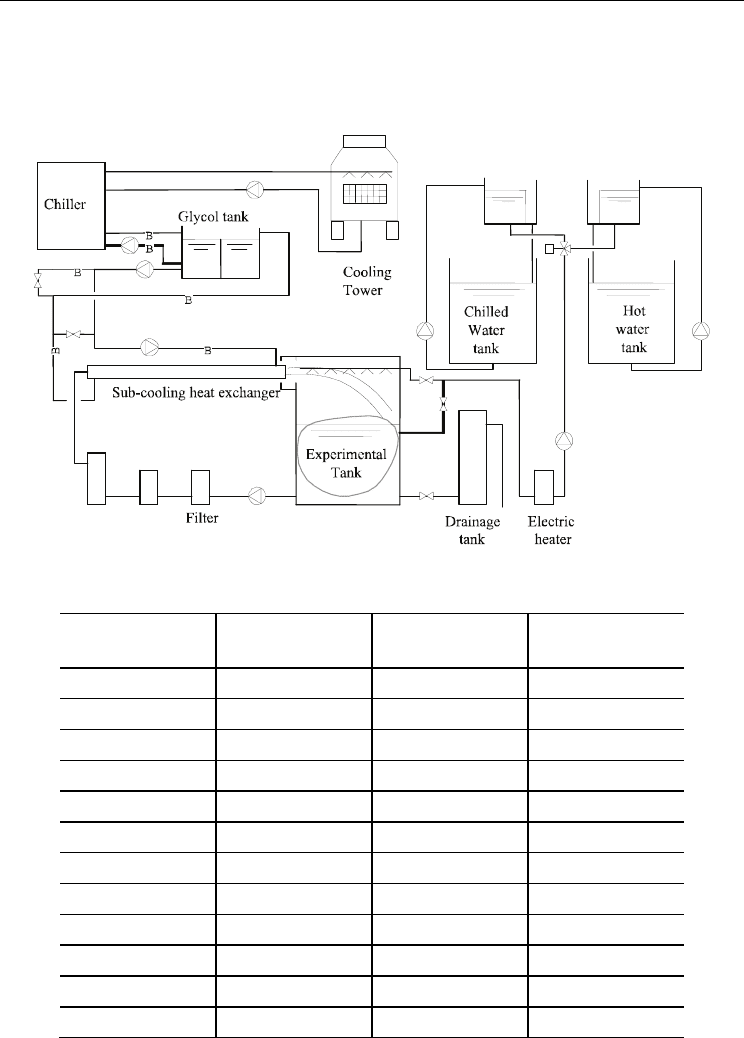
Two Phase Flow, Phase Change and Numerical Modeling
552
The flow rates of the glycol solution and the input water for melting were measured by
electromagnetic flow meters. Temperature profiles from 10 vertical points at two locations,
as well as the inlet and outlet temperatures, were measured. Melting was performed by
spray nozzles at the upper part of the tank.
Fig. 13. Schematic diagram of the experimental setup for slurry ice storage
Exp. no.
Initial temp.
[°C]
Charging time
[hr:min]
IPF
[%]
SD101C 15.8 4:30 43.9
SD102C 19.6 4:35 17.4
SD103C 16.4 4:20 58
SD104C 14.4 ------ 27.2
SD105C 11.7 4:30 44.6
SD106C 15.6 4:55 44.3
SD107C 13.0 4:40 34.4
SD108C 5.3 3:50 33.9
SD109C 16.1 4:40 45.8
SD110C 13.5 4:10 30.5
SD111C 16.8 4:05 31.9
SD112C 14.5 4:10 31.8
Table 5. Experimental conditions for the freezing process for the slurry ice storage tank
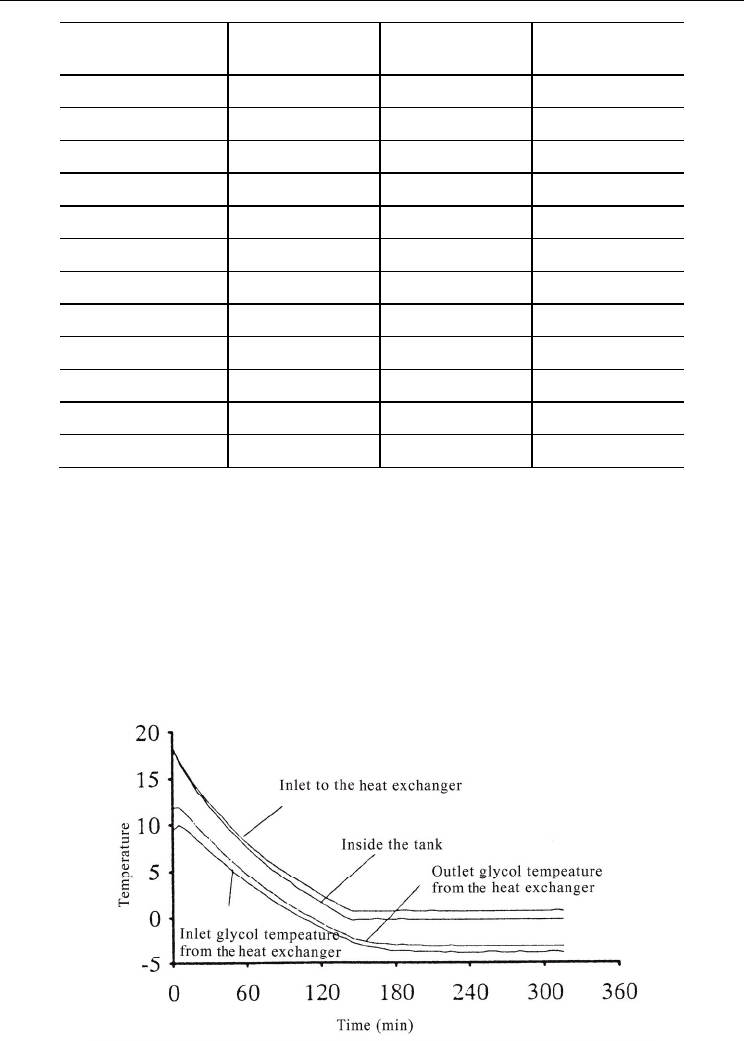
Thermal Energy Storage Tanks Using Phase Change Material (PCM) in HVAC Systems
553
Exp. no.
Inlet temp.
[°C]
Flow rate
[l/min]
Inlet heat
[kW]
SD101H 38.5 12.6 33.8
SD102H 29.7 16.1 33.4
SD103H 24.8 19.4 33.6
SD104H 17.5 27.3 33.3
SD105H 29.7 11.1 23.0
SD106H 24.6 12.9 22.1
SD107H 17.1 19.8 23.6
SD108H 13 24.9 22.6
SD109H 18 8.7 10.9
SD110H 12.3 10.6 9.1
SD111H 12.6 12.2 10.2
SD112H 9.9 15.7 10.8
Table 6. Experimental conditions for the freezing process for the slurry ice storage tank
2.7 Results
Figure 14 shows the temperature variation of the tank and the glycol solution during a
freezing process. Since sub-cooled water was injected from the heat exchanger into the tank,
the inside of the tank was completely mixed so that the temperature profile was uniform.
The temperature of the tank decreased from the beginning of the experiment and reached
0°C after two hours. Once the inside of the tank reached the freezing temperature, heat
extraction from the heat exchanger was used to form ice. Therefore, the temperature of the
glycol solution was maintained at approximately 4°C below the freezing point.
Fig. 14. Freezing process of the slurry ice storage tank
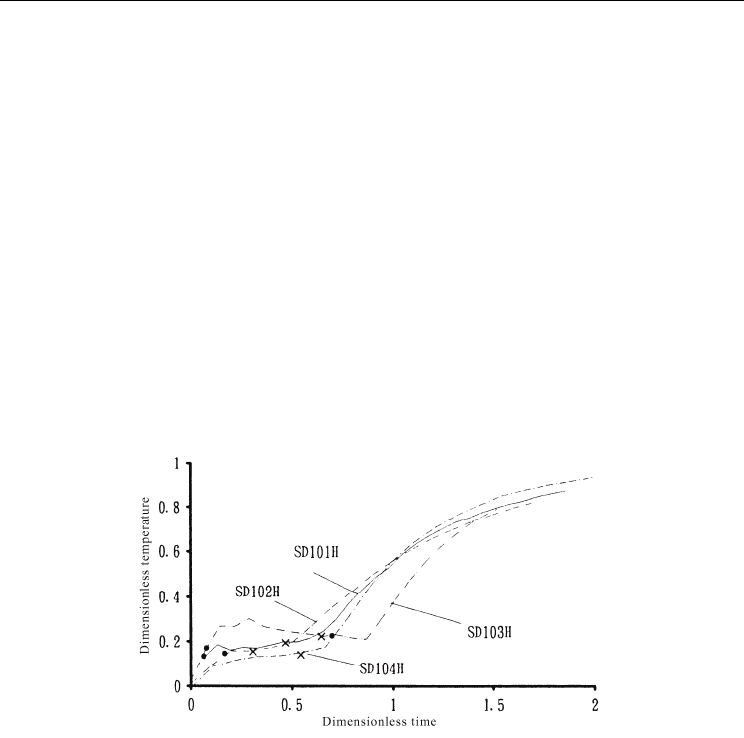
Two Phase Flow, Phase Change and Numerical Modeling
554
The injected water was released from its sub-cooled state by the collision, and 2% of the
water was frozen. Ice in the shape of tiny flakes was observed to float inside the tank. There
was no constraint on ice formation, which was different from that in the ice-on-coil ice
storage tank. After a certain amount of ice flakes was produced, a lump of ice formed by
agglomeration of the ice flakes. Experiments to examine the freezing process were continued
until the lump of ice extended to the bottom of the tank. The value of the IPF was calculated
from the heat balance between the extracted heat by the glycol solution and the sensible and
latent heat of water inside the tank. The IPF reached a higher value than that for the ice-on-
coil ice storage tank, in which the thickness of the ice was limited by the space between the
ice making coils.
Dimensionless output responses of melting processes are shown in Figures 15 and 16. Since
the temperature at the maximum density of water, i.e., 4°C, is also important for the slurry
ice type, the points at which the outlet temperature exceeded 4°C are indicated by filled
circles in the figures. The outlet temperature was maintained at temperature lower than 4°C
from the beginning of the experiments and increased to dimensionless temperatures of 0.7
to 1.0. The response shape indicated complete mixing and a lack of significant difference
between experimental conditions. The dimensionless time, when the response increased,
appeared earlier for larger inlet enthalpy flow rates.
Fig. 15. Dimensionless response of the melting process for slurry ice storage for large inlet
enthalpy flow rate
Considering the time at which the outlet temperature exceeded 4°C, the real temperature
before response increase differed for different inlet conditions. The temperature exceeded
4°C at a dimensionless time of approximately 0.1 for certain conditions. However, the
temperature remained above 4°C until a dimensionless time of approximately 0.8 for other
conditions. The dimensionless times at which the inlet enthalpy became equal to the latent
heat of the ice are indicated in the figures by cross symbols. As observed from the figures,
the temperature had already increased when ice remained present in the tank.
The time at which the outlet temperature exceeded 4°C is considered to depend on the
relationship between the enthalpy flow rate and the heat transfer to the ice. The ice in the
slurry ice tank was in the form of particles and was distributed over the entire tank.
Therefore, heat transfer occurred over a larger area than for the ice-on-coil ice storage tank,
and depended strongly on the state of mixing inside the tank. As the Archimedes number
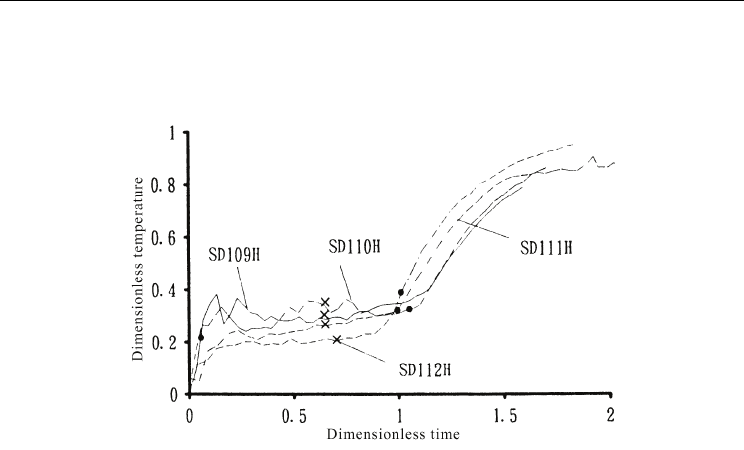
Thermal Energy Storage Tanks Using Phase Change Material (PCM) in HVAC Systems
555
became small, which indicates a higher velocity at the inlet, mixing inside the tank was
accelerated and so the heat transfer between ice and water was enhanced. Consequently, the
outlet temperature remained lower for small Archimedes numbers.
Fig. 16. Dimensionless response of the melting process of slurry ice storage for small inlet
enthalpy flow rate
The temperature of the outlet flow and its duration below 4°C are important for system
utilization. The efficiency defined by the dimensionless response was difficult to apply to
slurry ice storage, because the outlet temperature sometimes exceeded 4°C. Therefore, the
relationship between efficiencies and experimental conditions is not discussed for the case of
slurry ice storage.
3. Evaluation of a PCM storage system using paraffin waxes
Phase change materials other than ice and water have been extensively investigated as a TES
medium. In recent years, various commercially available materials have been developed.
Research on the use of PCMs in buildings have been conducted. The thermal characteristics
of building materials with PCMs, which could stabilize the temperature of a room, were
measured (Mehling, 2002). Organic compounds, such as fatty acids and paraffin waxes,
have also attracted attention as TES media. The melting temperature of a binary mixture of
these materials is adjustable to climate requirements (Kauranen et al. 1991). The heats of
fusion of these materials were from 120 to 160 kJ/kg (Feldman et al. 1989). Both heating and
cooling applications are attractive for use with binary mixtures of tetradecane and
hexadecane (He et al. 1999).
Several studies on building materials containing PCM have been conducted. Gypsum
boards combined with a mixture of fatty acids could reduce the fluctuation of room
temperature in the wintertime (Shilei et al. 2006). Floor panels mixed with PCM in an under-
floor electrical heating system were evaluated because of the availability of inexpensive
electricity during the nighttime (Lin et al. 2003). Applications of PCMs to ceilings and
wallboards, which were cooled during the nighttime and released stored energy for cooling
during the day, were examined (Barnard and Setterwall 2003, Lin et al. 2003 and Feldman et

Two Phase Flow, Phase Change and Numerical Modeling
556
al. 1995). These studies focused on the use of natural heat resources in conjunction with TES
technologies.
On the other hand, TES is commonly used in warm countries, because the electric peak
demand may be problematic. In such countries, electric consumption of heating, ventilating,
and air conditioning (HVAC) systems is concentrated during warm summer afternoons.
Therefore, the demand for electricity has a steep peak. This peak should be shaved to off-
peak hours in order to avoid electricity shortages. Water and ice storage can be used for this
purpose. Ice storage has become common, because the volume of the storage tank is smaller
than water storage tank due to the latent heat of water. However, chilling machines are less
efficient than ordinary machines used for comfort cooling. The use of a PCM having a
higher melting temperature than ice is promising because the operating temperature need
not be changed from ordinary operation.
Phase change material storage devices can be installed in the water circuit or the air circuit
of HVAC systems. Since the temperature difference between the PCM and the heat transfer
medium is needed in order to solidify or liquefy, an air circuit with a wide temperature
range was considered to be suitable. We proposed a system with PCM containers in the air
ducts. The materials selected in the present study were mixtures of various paraffin waxes,
which allowed the melting temperature to be adjusted by adjusting the concentration of
each material. Simple methods by which to determine the thermal properties of the PCM
were proposed by comparing the temperature response of the PCM samples with water
(Zheng et al. 1999 and Martin et al. 2003). In the present study, the thermal characteristics of
the mixtures were measured using a simple apparatus and simulations of an HVAC system
were conducted in order to evaluate various properties, such as the melting temperature or
the quantity of the mixture. The performance of the proposed system was evaluated using a
system simulation program.
3.1 Research methods
The melting temperature can be changed by adjusting the concentrations of paraffin waxes
(He et al. 1999). We used industrial grade paraffin waxes. Table 7 lists the concentrations of
the mixtures. The use of flammable liquids at 20°C in buildings is prohibited by Japanese
building codes. A fatty acid, namely, stearic acid with a high melting temperature, was
added to solidify the mixture of paraffin waxes. The apparatus shown in Figure 17 was used
to measure the thermal properties of the mixtures. The apparatus consisted of foam
polystyrene covered with acrylic plates. A cavity was located in the center of the apparatus,
which was filled with the mixture. The surface areas of the cavity were covered with heat
flux transducers. Thermocouples were placed inside the cavity.
Estimated
melting
temp.
Concentration
of paraffin wax
(t
m
: 18°C)
Concentration
of paraffin wax
(t
m
: 28°C)
Concentration
of stearic acid
Mass of
PCM (g)
MT 17 17°C (62.6°F) 40% 40% 20% 39.1
MT 19 19°C (66.2°F) 28% 52% 20% 40.4
MT 21 21°C (69.8°F) 24% 56% 20% 40.0
MT 23 23°C (73.4°F) 16% 64% 20% 38.5
Table 7. Concentrations of paraffin waxes and fatty acid used in the present study
t
m
: melting temperature
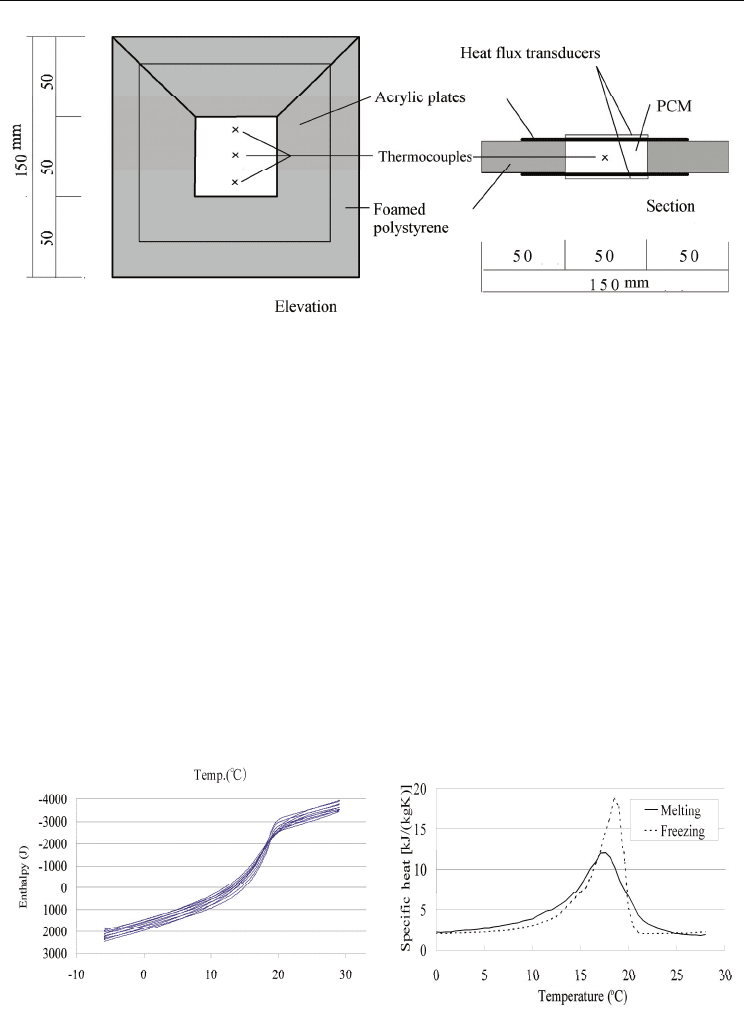
Thermal Energy Storage Tanks Using Phase Change Material (PCM) in HVAC Systems
557
Fig. 17. Experimental apparatus used to measure the thermal properties of the mixtures
The apparatus was placed in a small thermal chamber in which both temperature and
humidity could be controlled. The temperature inside the chamber was raised from –5°C to
30°C over seven hours. The temperature inside the chamber was maintained at 30°C for
three hours and decreased to –5°C over seven hours, before being maintained constant for
seven hours. One cycle of the experiment was continued over 24 hours, and seven cycles
were repeated for each measurement. The first and last cycles were not used for analysis
because of the instability of the experimental conditions.
3.2 Results
The results for the MT17 mixture are shown in Figure 18. The left-hand figure shows the
sum of the heat through the heat flux transducers versus the average temperature of the
thermocouples for five cycles. The specific heat could be obtained by differentiating the
curve as is shown on the right-hand side of the figure. The measured enthalpy was
integrated as latent heat in the temperature range for the phase change observed in Figure
2(b), where the temperature ranged from 11.5°C to 20.5°C for freezing and from 10.0°C to
21.5°C for melting. The results for all of the mixtures are listed in Table 2. The latent heat of
(a) (b)
Fig. 18. Results for the MT17 mixture

Two Phase Flow, Phase Change and Numerical Modeling
558
pure paraffin wax is approximately 200 kJ/kg. The mixtures had smaller latent heats than
the pure material. The measured latent heat was equivalent to the heat for a temperature
difference of 20°C for water.
The curves shown in Figure 18(b) were used for simulations, which used the enthalpy
method of the PCM. In the simulation program, the specific heat of the materials varied with
temperature according to the curves shown in the figure (Yamaha et al. 2001).
Materials Operations
Peak temperature
[°C]
Amount of latent heat
[kJ/kg]
MT 17
Freezing 18.5 86
Melting 17.5 77
MT 19
Freezing 21.5 87
Melting 20.5 86
MT 21
Freezing 21.5 85
Melting 20.5 87
MT 23
Freezing 21.5 76
Melting 22.0 83
Table 8. Thermal properties of materials
3.3 System simulations
The use of the mixtures was evaluated through computer simulations. The section and plan
of the building used in the simulations are shown in Figure 19, and a schematic diagram of
the system is shown in Figure 20. An air conditioning system for an office building was
assumed. The calculated area was part of one floor of an office building with a floor area of
73.8 m
2
that was assumed to be located in Nagoya City, Japan. The room had windows of
6.5 m
2
facing south, and the weather data used to calculate the peak load was the data for a
summer day. The wall was constructed using lightweight concrete and was insulated with
25-mm-thick foam urethane.
For charging operation, the air runs through the closed circuit of the PCM storage tank and
the air conditioner (Figure 20, (1)). After the end of the charging cycle, the ordinary air
conditioning operation was started. The conditioned air is projected into the room and
returned to the air conditioner after mixing with a volume of outdoor air. In this operation,
the air is assumed to bypass the PCM storage tank (Figure 20, (2)). For the discharging
operation, the air passes into the room through the PCM storage tank. In the charging and
discharging operations, the airflow rate is reduced to half that of the ordinary air
conditioning in order to store and recover heat effectively (Figure 20, (3)). The discharging
period started at 13:00 and ended at 16:00. In Japan, utility companies offer special discount
rates for peak shaving during this period.
Calculation was conducted using the enthalpy method, which assumed the heat of fusion of
PCM to be a specific heat c
p
(θ) that varied with temperature. The temperature of the PCM
was calculated by combining the experimental results shown in Figure 2 with the one-
dimensional heat conduction equation:
()
p
pp p
p
S
c
txxdz
θ
ρθθ λ
∂
∂∂
=+
∂∂∂
(12)
